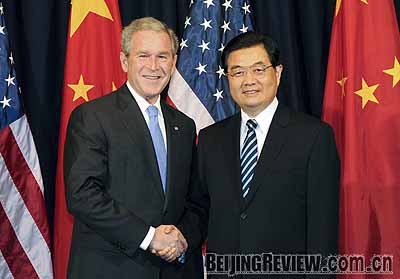|
 |
|
THREE DECADES OF FRIENDSHIP: Chinese President Hu Jintao (right) and U.S. President George W. Bush meet during the Asia-Pacific Economic Cooperation summit in Lima, Peru, on November 21, 2008 (XINHUA) |
Since China and the United States established diplomatic relations 30 years ago, their relations have forged ahead along a bumpy path. The two countries' common interests are increasing. Bilateral exchanges in various fields are expanding. Economic interdependence is growing. Their constructive partnership has made significant progress.
Remarkable changes have taken place in China-U.S. relations over the past three decades. A lot has happened during these years, including storms of tension that caused serious concerns. However, tribulations have not torn their relationship apart. There is always a rainbow after a storm hits China-U.S. relations.
From 1979 to May 1989, relations between China and the United States enjoyed all-round initial development as the two countries normalized relations and issued a joint communiqué on U.S. arms sales to Taiwan.
It is no coincidence that China and the United States established diplomatic relations as China inaugurated its reform and opening-up policy. The normalization of their bilateral relations was an important part of late Chinese leader Deng Xiaoping's grand vision. Deng, who spearheaded China's reform and opening up, underlined the importance of establishing diplomatic relations with the United States for shaping an international environment conducive to China's modernization drive. He conveyed the message on different occasions in 1977 and 1978, calling on U.S. President Jimmy Carter to make up his mind to establish diplomatic relations with China. As a major Chinese decision-maker, Deng presided over negotiations with the United States. At critical moments, he personally took part in the negotiations. The establishment of diplomatic relations opened a new chapter in China-U.S. relations.
Deng visited the United States in late January and early February 1979, the first visit by a Chinese leader to the United States since the People's Republic was founded in 1949. It not only gave momentum to the two countries' nascent diplomatic relations, but also had geopolitical implications worldwide. The years 1979 and 1980 witnessed frequent exchanges of visits by cabinet-level officials and their deputies. The two countries' relations surged forward as they signed dozens of cooperative agreements.
However, U.S. arms sales to Taiwan, an issue unresolved during the negotiations to establish diplomatic relations, soon posed a problem. In 1981, Taiwan authorities asked U.S. President Ronald Reagan for approval to purchase F-16 fighter jets from the United States. Deng not only balked at Taiwan's request, but also expounded on China's position while receiving foreign guests. "Should the Taiwan question force a regression in Sino-U.S. relations, China will definitely not give way," he told senior Reagan administration officials. "If something forces a regression in relations, we cannot but face reality squarely."
After tough negotiations, China and the United States issued a joint communiqué on U.S. arms sales to Taiwan, known as the August 17 Communiqué, in August 1982. In the communiqué, the U.S. Government stated that it "does not seek to carry out a long-term policy of arms sales to Taiwan." The U.S. Government expressed its intention to gradually reduce arms sales to Taiwan, leading to a final resolution over a period of time. The Taiwan question ceased to be an outstanding problem in China-U.S. relations for some time after the two countries issued the August 17 Communiqué. As a result, their relations made great strides.
From the summer of 1989 to the end of 2000, China-U.S. relations moved toward stability after a series of fluctuations.
Three major fluctuations took place during this period. China-U.S. relations were put to the test when the United States and other Western countries jointly mounted pressure on China following the political turmoil in Beijing in 1989. In 1995, the U.S. Government issued a visa to Taiwan leader Lee Teng-hui, severely jeopardizing China-U.S. relations. In May 1999, U.S.-led NATO forces bombed the Chinese Embassy in Belgrade. Although American officials said it was an accident, the incident plunged the two countries' relations to a low point.
| 